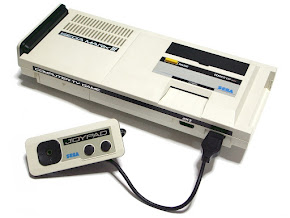SG-1000 and Sega Mark III
Sega Master System
For its release in the US in 1986, they built a different case for the console and renamed it the Master System. Its only differences from the Sega Mark were the inability to play games from cartridges and cards from the SG-1000, SG-1000 II and Sega Mark III (only with an adapter for cartridge games only) and the lack of support for FM sound, which in the Japanese version, released in 1987, did not exist, since it supported all cartridges and cards from Sega consoles (including the American Master System cartridges) and came with FM sound support integrated into the console, without the need for an add-on. It was common at the time for this difference in compatibility to exist due to the regionality of each console, so as to avoid competition between different countries in the production of games for the same system.
Master System II and III (Boxes)
its hardware superiority over its competitor, the Famicom, which had a CPU of 1.79 MHz versus 3.58 MHz, 2kB of RAM and video versus 8kB of RAM and 16kB of video, and despite 48 total colors and 25 simultaneous colors versus 64 total colors and 32 simultaneous colors, neither in the Sega Mark III era nor in the Master System era did it surpass Nintendo's console in sales. Despite this, it was very successful in Europe and Brazil, being released in 1987 and 1989, respectively. In 1990, Sega released a second version of the console in the US and Europe, called the Master System II, a compact version of the device, later released in Brazil as the Master System III Compact. The Master System II in Brazil, released in 1991, was the same original Master System, but with a lower price and with Alex Kidd In Miracle World in memory.
Master System Games
Among its games, several successful franchises began on the device or came to it from the arcades, such as racing games, such as Enduro Racer, Ayrton Senna's Super Monaco GP ii, Chase HQ, OutRun, Hang-On and Road Rash; puzzle games, such as Flash Point, Lemmings and Columns; sports games, such as FIFA, California Games, World Cup, Sega World Tournament Golf and the Great line of games, such as Golf, Baseball Masketball and others; action/platform games, such as Action Fighter, Alex Kidd, Ghostbuster, Wonder Boy, Ninja Gaiden, Strider, Ghouls 'n Ghosts, Golvellius, Asterix, Sonic Chaos, Kenseiden, Psycho Fox, Jurassic Park, Earthworm Jim and Sonic The Hedgehog; and beat 'em up games, such as Double Dragon, Altered Beast, Golden Axe, Black Belt, Streets of Rage and Renegade. Shmup/shoot em up games include Operation Wolf, After Burner, Space Harrier, Fantasy Zone, Power Strike, R-Type and Galaxian. Fighting games include Virtua Fighter Animation and Mortal Kombat II. And RPGs include Phantasy Star, Golden Axe Warrior and Dragon Crystal. There were also games from companies such as Disney, such as Mickey (Legend, Land and Castle of Illusion), The Lion King, Donald Duck, Aladdin and The Jungle Book. DC Comics, such as The Flash and Batman Returns and Superman: The Man of Steel. Marvel, such as Spider-Man vs. The Kingpin and Return of the Sinister Six, The Incredible Hulk and X-Men: Mojo World. And Warner, such as Taz-Mania and Escape from Mars, Daffy Duck (Daffy Duck In Hollywood), Desert Speedtrap, Cheese Cat-Astrophe, Tom and Jerry (The Movie) and The Flintstones. Anime games were also released, such as Zillion, Borgman and Hokuto no Ken. Although there was no direct competition with the Famicom, the two consoles competed for several ports, such as Aladdin, Alien 3, Asterix, Back to the Future, Battletoads, Bubble Bobble, Juggle Book, Lion King, Operation Wolf, Pacman, Paperboy, Robocop 3, Strider, Terminator, Ninja Gaiden, Double Dragon, Jurassic Park and others. Last but not least, Brazilian games, such as Mônica no Castelo do Dragão, Chapolin x Drácula, Férias Frustradas do Pica-Pau, Castelo Rá-Tim-Bum, TV Colosso and others.
Master System II and III (Consoles)
The console was discontinued in 1989, however, in the USA it continued until 1991 and in Europe until 1996. In Brazil it is still sold today, with games produced in the country until the end of the 1990s. The country in which the console was most successful was undoubtedly Brazil.
Master System releases in Brazil:
Master System (1989)
Master System II (1991)
Master System 3D (1991)
Master System III Compact (1992/1993/1998)
Master System Super Compact (1993)
Master System Super Girl (1993)
Master System III Collection (2002)
Master System III Collection (2004)
Master System III Collection (2005)
Master System III Collection (2006)
Master System III Collection (2007)
Master System III (2008)
Master System III Evolution (2011)
Master System® Plug & Play (2018)
Master System® Portable (2018)








.jpg)
.jpeg)
.jpeg)
.jpg)
.jpg)
.jpg)
.jpg)


No comments:
Post a Comment